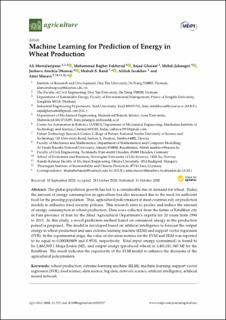| dc.contributor.author | Mostafaeipour, Ali | |
| dc.contributor.author | Fakhrzad, Mohammad Bagher | |
| dc.contributor.author | Gharaat, Sajad | |
| dc.contributor.author | Jahangiri, Mehdi | |
| dc.contributor.author | Dhanraj, Joshuva Arockia | |
| dc.contributor.author | Band, Shahab | |
| dc.contributor.author | Issakhov, Alibek | |
| dc.contributor.author | Mosavi, Amirhosein | |
| dc.date.accessioned | 2020-12-16T11:38:34Z | |
| dc.date.available | 2020-12-16T11:38:34Z | |
| dc.date.created | 2020-12-11T18:36:43Z | |
| dc.date.issued | 2020 | |
| dc.identifier.citation | Agriculture, 2020, 10(11), 517 | en_US |
| dc.identifier.issn | 2077-0472 | |
| dc.identifier.uri | https://hdl.handle.net/11250/2719795 | |
| dc.description.abstract | The global population growth has led to a considerable rise in demand for wheat. Today, the amount of energy consumption in agriculture has also increased due to the need for sufficient food for the growing population. Thus, agricultural policymakers in most countries rely on prediction models to influence food security policies. This research aims to predict and reduce the amount of energy consumption in wheat production. Data were collected from the farms of Estahban city in Fars province of Iran by the Jihad Agricultural Department’s experts for 20 years from 1994 to 2013. In this study, a novel prediction method based on consumed energy in the production period is proposed. The model is developed based on artificial intelligence to forecast the output energy in wheat production and uses extreme learning machine (ELM) and support vector regression (SVR). In the experimental stage, the value of elevation metrics for the EVM and ELM was reported to be equal to 0.000000409 and 0.9531, respectively. Total input energy (consumed) is found to be 1,460,503.1 Mega Joules (MJ), and output energy (produced wheat) is 1,401,011.945 MJ for the Estahban. The result indicates the superiority of the ELM model to enhance the decisions of the agricultural policymakers. | en_US |
| dc.language.iso | eng | en_US |
| dc.rights | Attribution-NonCommercial-NoDerivatives 4.0 Internasjonal | * |
| dc.rights.uri | http://creativecommons.org/licenses/by-nc-nd/4.0/deed.no | * |
| dc.title | Machine Learning for Prediction of Energy in Wheat Production | en_US |
| dc.type | Peer reviewed | en_US |
| dc.type | Journal article | en_US |
| dc.description.version | publishedVersion | en_US |
| dc.source.volume | 10 | en_US |
| dc.source.journal | Agriculture | en_US |
| dc.source.issue | 11 | en_US |
| dc.identifier.doi | 10.3390/agriculture10110517 | |
| dc.identifier.cristin | 1858947 | |
| dc.source.articlenumber | 517 | en_US |
| cristin.ispublished | true | |
| cristin.fulltext | original | |
| cristin.qualitycode | 1 | |

